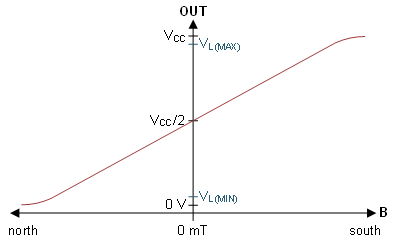SBAS639D October 2017 – June 2024 DRV5055-Q1
PRODUCTION DATA
- 1
- 1 Features
- 2 Applications
- 3 Description
- 4 Pin Configuration and Functions
- 5 Specifications
- 6 Detailed Description
- 7 Application and Implementation
- 8 Device and Documentation Support
- 9 Revision History
- 10Mechanical, Packaging, and Orderable Information
Package Options
Mechanical Data (Package|Pins)
Thermal pad, mechanical data (Package|Pins)
Orderable Information
6.3.3 Sensitivity Linearity
The device produces a linear response when the output voltage is within the specified VL range. Outside this range, sensitivity is reduced and nonlinear. Figure 6-3 graphs the magnetic response.
 Figure 6-3 Magnetic Response
Figure 6-3 Magnetic Response Equation 2 calculates parameter BL, the minimum linear sensing range at 25°C taking into account the maximum quiescent voltage and sensitivity tolerances.

The parameter SLE defines linearity error as the difference in sensitivity between any two positive B values, and any two negative B values, while the output is within the VL range.
The parameter SSE defines symmetry error as the difference in sensitivity between any positive B value and the negative B value of the same magnitude, while the output voltage is within the VL range.